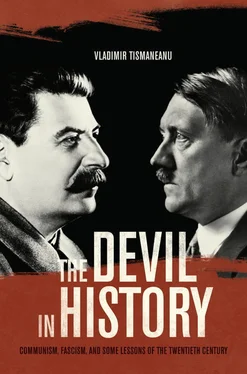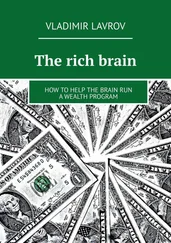Beyond debates about how to remember, compare, and analyze Communism and Fascism, there is a bottom line that all can accept. Perhaps with minimal difficulty all can agree with Emilio Gentile’s conclusion that “totalitarian experiments, even if they were imperfect and flawed, involved, conditioned, transformed, deformed and ended the existence of millions of human beings. In no uncertain terms, this was determined by the conviction of the principal protagonists that they were the forebears of a new humanity, the builders of a new civilization, the interpreters of a new truth, the repositories for the discrimination between good and evil, and the masters of the destinies of those caught up in their enterprise.” 139At the end of the day, reflecting on the “why” of the whole Communist experience, one needs to remember that Leninism emerged from the meeting between a certain direction of European revolutionary socialism, one that could in no way come to terms with the established liberal order and the rights of the individual, and the Russian tradition of conspiratorial violence. The mixture of revolutionary anticapitalism and ultranationalist German racism led to Hitler’s chiliastic dreams of Aryan supremacy. 140At a speech in the Berlin Sports Palace on February 10, 1933, Hitler formulated with religious fervor his “predestined mission” to resurrect the German nation: “For I cannot divest of my faith in my people, cannot dissociate myself from the conviction that this nation will one day rise again, cannot divorce myself from my love for this, my people, and I cherish the firm conviction that the hour will come at last in which the millions who despise us today will stand by us and with us will hail the new, hard-won and painfully acquired German Reich we have created together, the new German kingdom of greatness and power and glory and justice. Amen.” 141Similarly, Mussolini confessed in My Autobiography that “I felt the deep need for an original conception capable of bringing about a more fruitful rhythm of history in a new period of history. It was necessary to lay the foundation of a new civilization.” Fascism for Mussolini was the solution to “the Spiritual Crisis of Italy.” 142The same frenzy for “a new temporality and nomos,” alternative and opposite to that of liberal modernity, was also at the core of Communism. Such a sense of mission was apparent at the Congress of Victors (the Seventeenth Congress of the Communist Party of the Soviet Union) in January-February 1934, as the Soviet regime entered the second five-year plan and finalized the Cultural Revolution, after Stalin had murdered, starved, and deported millions of kulaks in Ukraine and forcibly resettled several ethnic groups, and as he consolidated his position as undisputed leader of the Bolshevik party. At such a “glorious moment,” almost two and a half years before the beginning of the Great Terror, Politburo member Lazar Kaganovich praised Stalin as the creator “of the greatest revolution that human history has ever known.” 143
The plight of Communism’s millions of victims (many of whom had once espoused the generous promises of the Marxian doctrine) cannot be explained without reference to the Leninist party and its attempt to forcibly impose the will of a small group of fanatics over reticent and more often than not hostile populations. Mikhail Bakunin put it most aptly in an angry letter disavowing Sergey Nechaev’s apotheosis of destructive violence and psychological terrorism: “Out of that cruel renunciation and extreme fanaticism you now want to make a general principle applicable to the whole community. You want crazy things, impossible things, the total negation of nature, man, and society!” 144Communism and Fascism believed that fundamental change was possible. They engineered radical revolutionary projects in order to answer this belief. 145However, they enacted their utopias with complete disregard for individual human life. Their frantic acceleration of human development engendered the materialization of radical evil in history.
CHAPTER 2
Diabolical Pedagogy and the (Il) logic of Stalinism
I am too busy defending innocents claiming their innocence to waste my time with guilty individuals claiming their guilt.
—Paul Éluard, refusing to sign a petition against the hanging of Czech surrealist poet Zàšvis Kalandra (in Stéphane Courtois,
The Black Book of Communism)
Lucrețiu Pătrășcanu died as a soldier serving his political ideals which he pursued through darkness, underground, and palaces, tenaciously, fiercely and fanatically.
—Petre Pandrea,
Memoriile Mandarinului Valah (Memoirs of a Wallachian Mandarin)
With ascetic rigor towards itself and others, fanatical hatred for enemies and heretics, sectarian bigotry and an unlimited despotism fed on the awareness of its own infallibility, this monastic order labors to satisfy earthly, too “human” concerns.
—Semyon Frank,
Vekhi (Landmarks)
It’s not only the word “impossible” that has gone out of circulation, “unimaginable” also has no validity anymore.
—Victor Klemperer,
I Will Bear Witness
One of the main distinctions between the Nazi and Stalinist tyrannies was the absence in Germany of permanent purges of the ruling party elite as a mechanism of mobilization, integration, and scapegoating. In fact, Slovene philosopher Slavoj Žižek is right to observe that there were no Moscow-style show trials in Hitler’s Germany (or for that matter in Mussolini’s Italy). 1The explanation lies in the differences between the centrality of the charismatic party in Bolshevik regimes and the prevailing status of the leader in Fascist dictatorships. This is not say that the leader (whether Stalin, Mao, Mátyás Rákosi, Gheorghe Gheorghiu-Dej, Klement Gottwald, or Enver Hoxha) was not an omnipotent figure under Leninism, but his cultic power derived from the apotheosis of the party as the carrier of history’s behests. The absence of show trials in Nazi Germany did not eliminate purges as a means to consolidate the Führer’s power. 2The Blomberg-Frisch affair, when Hitler entrenched his dominance over the army leadership, and the elimination of the Ernst Rohm SA faction during the Night of the Long Knives in 1934, were, according to Ian Kershaw, “stepping-stones in cementing Hitler’s absolute power.” 3
In order to understand the dynamics of the Stalinist experiment in Eastern Europe, one must take into account the paramount role of direct Soviet intervention and intimidation. 4Local Communist formations were pursuing the Stalinist model of systematic destruction of non-Communist parties, the disintegration of the civil society, and the monopolistic occupation of the public space through state-controlled ideological rituals and coercive institutions. 5The overall goal was to build a passive consensus based on unlimited commitment to the ideocratic political program of the ruling elite. The true content of the political regime was described by the “cult of personality.” Stalin, as the Egocrat (to use Solzhenitsyn’s term), was the ultimate figure of power. Echoing earlier critiques of the Leninist vertical-authoritarian logic by Leon Trotsky and Rosa Luxemburg, French political philosopher Claude Lefort points out that this principle presupposed a specific “logic of identification”: “Identification of the people with the proletariat, of the proletariat with the party, of the party with the leadership, of the leadership with the Egocrat…. The denial of social division goes hand in hand with the denial of a symbolic distinction which is constitutive of society.” 6The personalization of political power, its concentration in the hands of a demigod, led to his forcible religious adoration and the masochistic humiliation of its subjects. British journalist George Urban described this system as “a paranoia of despotism” that boasted its own (il) logic. It looks now and did then “like a form of madness to us , observing it as we are from the outside, but did not seem so to anyone identifying himself with the context in which Stalin operated. Within that context Stalin pursued his objectives relentlessly and rationally.” 7In the context of such absolute inversion of the life-world, Old Bolshevik Nikolai Bukharin’s letter to Stalin on December 10, 1937, a few months before his public trial and execution as an “enemy of the people” in March 1938, can make sense. Bukharin, like Karl Radek, another Bolshevik luminary, was the prototype of the character Nikolai Salmanovich Rubashov in Arthur Koestler’s masterpiece Darkness at Noon (it was Radek who spoke of the “algebra of confession”). 8As historians J. Arch Getty and Oleg V. Naumov point out, “According to Stalin’s formula, criticism was the same as opposition; opposition inevitably implied conspiracy; conspiracy meant treason. Algebraically, therefore, the slightest opposition to the regime or failure to report such opposition was tantamount to terrorism.” 9
Читать дальше












